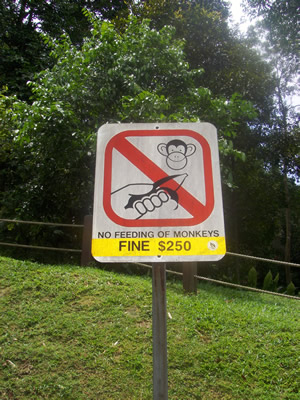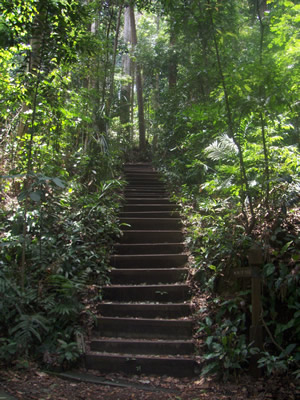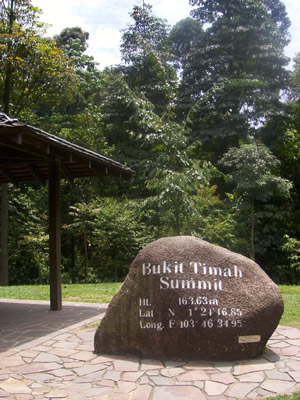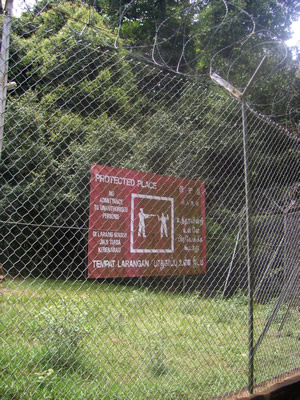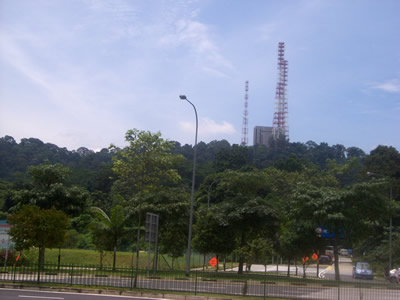Mountaineering in Singapore
I've lived here for eight months, so it is hard to believe that I had never been to the top of the highest "mountain" in Singapore. The highest point on the island is called Bukit Timah. In Bahasa Malay, Bukit is the word for hill and Timah is the word for tin, so it is Tin Hill. The origin of the name is somewhat uncertain since there is no record of tin ever being found or mined there. It is located right at the center of the island. It's 163 meters high - that's about 530 feet for those of you who still live in the nineteenth century or in backward countries like the United States. Not exactly a mountaineering challenge. But it is the highest point on the island, so I figured that sooner or later I had to get to the top of it.
This Wednesday seemed like a good day to go for it. The weather here has been very unusual for a while. Our normal rainy season is November through February, but it has rained every day for the last two weeks. And while the usual pattern here when it does rain is to have a heavy shower sometime during the day for a half hour or so, this week we have had several days when it rained all day. People here have really been complaining about how cold it has been too. Seems like everyone is getting sick, and people are saying it is because winter has already arrived. To give you an idea of just how cold it has been, we actually had one day last week when the temperature never reached 80 degrees! The locals are freezing.
After all the rain it was finally a sunny day. That has it's downside too, as it was HOT. But better than rain. So it was time for me to go up Bukit Timah. The first thing was to get there. It just happens that there is a major north-south road that goes from one end of the island to the other. It passes a few blocks from our apartment and also passes near Bukit Timah. It's called, appropriately, Bukit Timah Road. Or half of it is. It is a divided highway. And each side of the road has a different name. So the northbound side of the road is called Bukit Timah Road. The southbound side of the road is Dunearn Road. Except near the southern end of the island, where both sides of the road change name to Rochor Road. Confused yet?
For a walk through town, it is actually quite pretty walking up Bukit Timah Road. It is divided highway most of the way. The center divider and sometimes both sides of the road have beautiful, tall tropical trees and lots of flowering bushes and plants. And of course since the weather is pretty constant they always seem to be in bloom. I have never seen so many different types, or such intensely colorful flowers as there are in Singapore. And although there are a few high rise buildings, most of the houses and businesses are one or two stories. Most of the hosues are quite nice and the businesses are mostly upscale. It is kind of interesting to see a car dealership crammed into a space that would be a Seven Eleven store in the US. There was also one section where both sides of the road were lined with schools. One of them, the Singapore Chinese School, was at least as big as the Singapore American School (which has 3000 students). Interestingly, the team that was out on the sports field practicing when I went by was playing - baseball! It is popular on the Pacific Rim in places like Japan, Korea and Taiwan but I had never seen anyone here playing it before. I certainly don't think of it as a Chinese sport. Then again, I never used to think of basketball as a Chinese sport either.
After walking about five miles, I finally got to the turnoff to go up the hill. The area around it is set aside as the Bukit Timah Nature Reserve. It is one of the few areas kept in a natural state on the island. Since Singapore is so urban, it is easy to forget that if the city wasn't here, it would be tropical rainforest jungle. The vegetation is quite dense. No off trail wandering here. The jungle is dominated by tall trees - like 100 feet tall or more. They provide a dense canopy so that the floor of the forest is always shaded. That was welcome after two hours of walking in the hot sun to get there. But even in the gloom the floor of the forest was covered with smaller bushes, shrubs and plants. It was very dense. And the trees and shrubs all had other plants growing on them. And those plants had moss on them. Even the rocks were green from being coated with moss. Basically, with the heat and humidity and rainfall, Singapore is plant heaven. Which also means that there is a tremendous variety of plant species here. The nature reserve is only four acres, but according to the famous English botonist, David Bellamy, there are more plant species in the reserve than in all of North America. I thought that was totally amazing until I did a little research on it. The statement is quoted around Singapore fairly often. Sometimes it is changed to more species of trees than in North America. And Bellamy, the botanist who made the claim, is an interesting fellow. He is quite famous for many scientific papers in botany as well as many books written about biology for a general audience. But a few years ago his reputation was severely damaged when he wrote a very widely quoted letter to several major publications claiming that global warming was junk science and that important studies showed it wasn't happening at all. When followed up, it turned out that the articles he quoted as sources of his data didn't exist, and one of his main data points he later admitted was a typing mistake! No one is sure whether he was being dishonest or just getting senile. (No wonder people think there is still scientific controversy over global warming.) But it makes me wonder about his statement. But regardlessy, there really are lots and lots of species of plants in a very small area.
There are also quite a few animals in the reserve and in the adjacent Central Catchment Reserve (forest land around the two main reservoirs for the city of Singapore). Wild monkeys (long-tailed macaques, to be precise) can actually be quite a nuisance here. There are lots of signs reminding people not to feed the monkeys. Years ago before the city of Singapore spread over the island, Bukit Timah was actually avoided because of all the tigers in the area. But the last tiger on Singapore island was killed in 1930. So I felt pretty safe. I didn't even see a macaque. But I did see a 3 ft monitor lizard. It was right next to the trail near the visitor center. Unfortunately just as I was about to take a picture, someone came roaring by on their motorcycle and scared it away. But I did get a really close look at it before that. It was awesome. You can see a picture and find out more about it here.
The trail to the summit was short but steep. Part of it is really a paved service road. For the last little bit there is a hiking trail that takes off that is a staircase the entire way. But it didn't take long and I was on the top. There is a marker and shelter on the top in a small clearing. There are also two large antennas. There is a small clearing at the top but it is completely surrounded by trees. So there is absoulutely no view. Too bad, as it would have been interesting from there. I really didn't expect to be able to see anything though.
Bukit Timah is also the site of one of the last battles fought in February 1942 before the surrender of Singapore. After the Japanese took Bukit Timah they pushed the British back to where they had no access to the reservoirs in the center of the island. The final battle lines were only a few blocks from where we live. The British counterattacked up Bukit Timah Road (basically the route I had walked) to try to retake the hill and gain access to the reservoirs. The Japanese pushed them back. With a million people in the city and no fresh water supply, the British had no choice but to surrender a few days later. Both POW's and the civilian population suffered greatly during the occupation. Near the Visitor Center in the Reserve there is a memorial to the battle.
